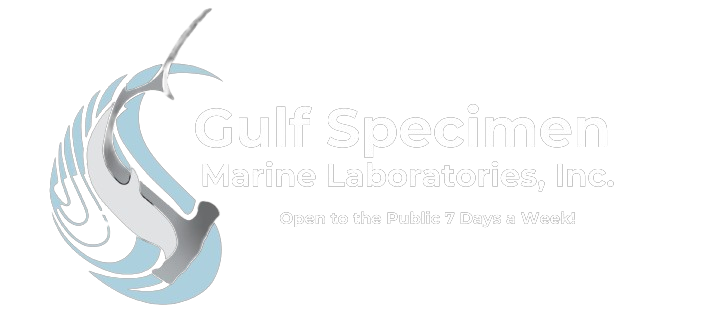Our guided tours are a popular educational experience from small families, group activity outings to larger homeschool groups. All tours are led by a tour leader who has been extensively trained. The tour leader identifies animals and plants, describes their natural history, explains habitat requirements and discusses human impacts on coastal natural resources. Tours are suitable for all ages from seniors to young children that are curious about the wonders of the Gulf.
Option 1: Guided Aquarium Tour:
Per Person/Adult or Child – $9.50 Minimum Group Charge – $114.00 (If your group is less than 12 people)
Duration: ~1 Hour
A tour guide will join your group and give an in-depth tour of the aquarium, explaining the biology of the animals and answering any questions you may have. Enjoy a special, one-on-one private feeding of our sharks, stingrays, fish or octopus!
Option 2: Aquarium and Living Dock Tour:
Per Person/Adult or Child – $12.50 Minimum Group Charge – $188.00 (If your group is less than 15 people)
Duration: ~2 Hours

After a guided tour of the aquarium, the group will continue on outdoors to the Living Dock located in the estuarine waters of Dickerson Bay. Visit the famous Living Dock, featured in Jack Rudloe’s book. There, the tour guide will demonstrate the fouling community species and intertidal zonation of barnacles and oysters. Participants get to experience hands on specimen collection from the dock to be identified and viewed up close before being released.
Option 3: Aquarium, Living Dock and Marsh Tour:
Per Person/Adult or Child – $16.50 Minimum Group Charge – $298.00 (If your group is less than 18 people)
Duration: ~3 Hours
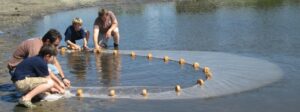
Join us for a three hour aquarium, dock and marsh tour. Feed some sharks, learn to bait crab traps and experience specimen collection with us! Use a beam trawl and seine net for the first time to collect common estuarine specimens like blue crabs, grass shrimp, and sea nettles. Learn about important keystone species that live and depend on salt marshes and witness the different juvenile stages of our local game fish in the wild. Participants are strongly encouraged to help!
The group can either break for lunch before the marsh tour or have lunch after the trip at the discretion of the teachers and drivers.
From 1989 to the present we have hosted over 20,000 visitors annually and over 100 school groups from the southeast. The response is always enthusiastic. Please plan well in advance as our tours are very popular and available dates can be limited.
Recommendations for Tour Participants
• Teachers, parents and chaperones are expected to keep a watchful eye and assist with children at all times, which will ensure a positive field trip experience for all! Children need to stay with their group at all times.
• Please practice appropriate cell phone manners.
• Most public schools require 1 chaperone per 5 students at the elementary level, 1 chaperone per 10 students middle and high school level.
• Wear appropriate clothing for current weather conditions. Depending on the weather either wear warm clothing or for hot weather a hat or clothing to shield from the sun is recommended.
• Wear clothes you do not mind getting wet or dirty.
• If you participate in a marsh tour expect to get wet! Bring bathing suit and change of shoes Be advised your shoes will be wet and covered in sand after the marsh tour.
• Wear sunscreen as needed.
• Bug spray (Hands and forearms must be washed before placing these in touch tanks) Chemicals are bad for the animals.
• Bring money for the Gift Shop.
Option 4: EXPLORING THE OTTER LAKE UNIT OF ST. MARKS NATIONAL WILDLIFE REFUGE
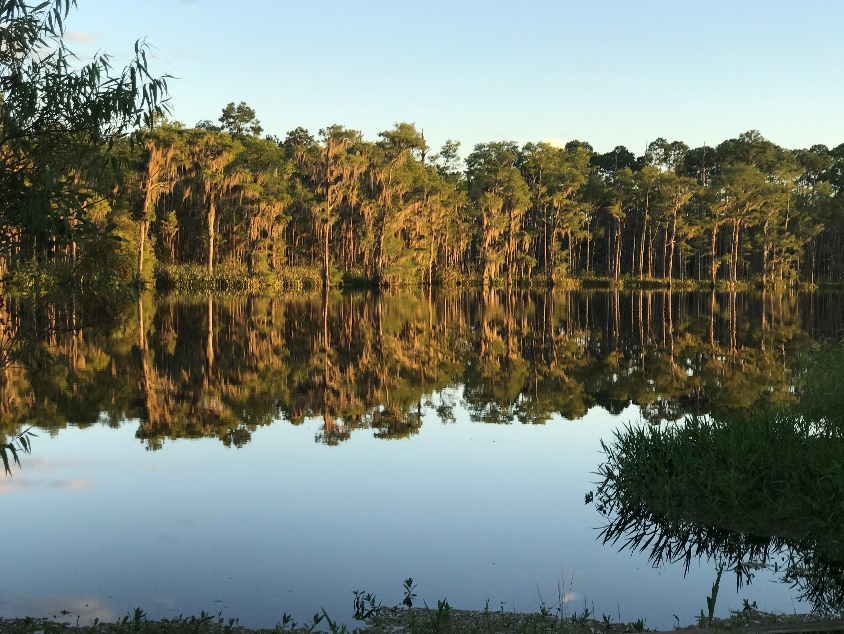
Otter Lake in Panacea, Florida
We are pleased to announce that Gulf Specimen Marine Lab has secured a Memorandum of Understanding (MOU) from the St. Marks National Wildlife allowing our educational classes to tour the wildness roads of the Otter Lake Unit in Panacea. The goal of our Trees to Shrimp class is to give hands on experience exploring the relationships and connections between the uplands and the marine environment. Grouper, red snapper, shrimp, crabs and oysters are all directly or indirectly eating trees. When it rains, “Swamp Tea”, made from dissolved phytochemicals of decaying oaks, pines, cypress and palmetto leaves flow down the rivers and out to sea. The churning waves of hurricanes scour the bays, flushing mud and detritus offshore where it becomes food for polychaete worms and shrimp. Oysters grow on washed out trees which are devoured by shipworms and gribbles.
The land feeds the oceans and the oceans feed the land. Fifty miles out at sea, 22% percent of baby sea turtles’ diets are terrestrial insects, including those nasty sand gnats and biting flies. Cormorants that spend their days feeding on fish at sea come home to roost in the cypress trees that fringe Otter Lake. Their droppings are eagerly sought by fresh water catfish and turtles, which in turn are fed upon by alligators. Forest fires send ash out to sea fertilizing phytoplankton, the base of the food chain.
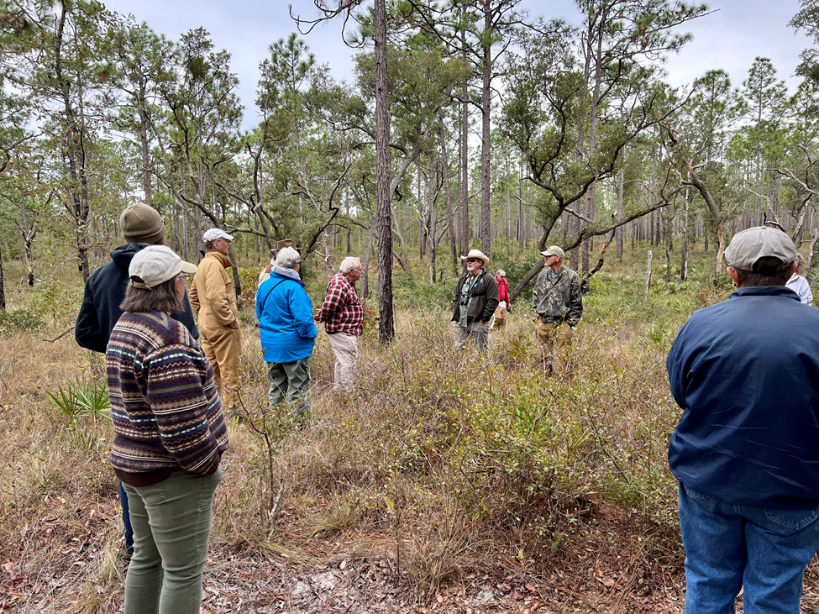
Touring the long leaf wire grass community of Otter Lake shores.
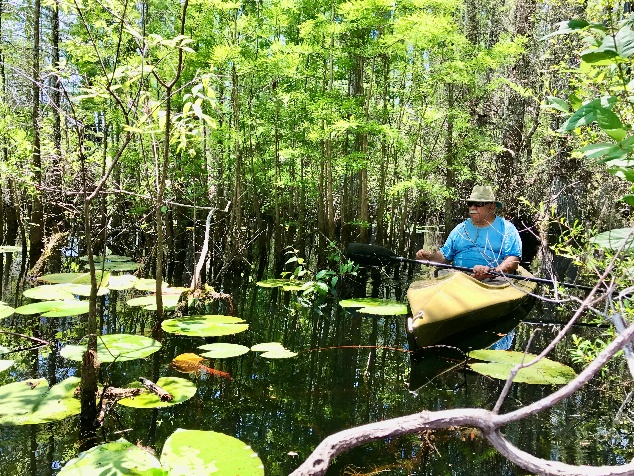
Kayaking on Alligator Lake, our private inholding in the St. Marks National Wildlife Refuge.
The wild lands of the St. Marks National Wildlife Refuges Otter Lake Unit are a crazy quilt of forest, wetlands, freshwater ponds and streams filled with wildlife, many of which are threatened or endangered. With luck you may see gopher tortoises, eastern diamond back rattlesnakes, alligators, bald eagles, a bobcat or black bear and wading birds galore. The old growth pines, painted with white bands mark trees where critically endangered red cockaded woodpecker nest.
See our article in National Wildlife Magazine, “Why We Sunk our Money Into a Swamp.
https://gulfspecimen.org/wp-content/themes/gulfspecimens/media/articles/7-NW-Swamp-85.pdf

Option 5: Beach Explorations Tour
Exploring a beach is always interesting. You never know what you may find from one day to the next, from one tide to the next, from one season to the next, from one step to the next! Beaches are an easily accessible margin of the “great ocean wilderness”. Simply taking a walk on a beach gives you a chance to discover some of the diversity of life that is mostly hidden under the water.
Some of the best times to explore a beach are at times of low and mid tides. Depending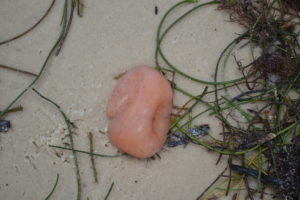 on the location and time of year, the bits and pieces brought in by the tide will give a clue as to what lives just off shore in the sea grass beds, sand flats, and limestone outcrops. There may be elegant angelwing clam shells, colorful giant heart cockle shells, red and yellow sea whips, egg cases from whelks or skates, sponges, sea urchins, algae, conch shells, the empty molts of horse shoe crabs and shrimp discarded as they grow, or an interesting piece of driftwood, and that “blob on the beach” that doesn’t seem to be anything recognizable!
on the location and time of year, the bits and pieces brought in by the tide will give a clue as to what lives just off shore in the sea grass beds, sand flats, and limestone outcrops. There may be elegant angelwing clam shells, colorful giant heart cockle shells, red and yellow sea whips, egg cases from whelks or skates, sponges, sea urchins, algae, conch shells, the empty molts of horse shoe crabs and shrimp discarded as they grow, or an interesting piece of driftwood, and that “blob on the beach” that doesn’t seem to be anything recognizable!
The twice monthly extreme low tides that expose the sand and mud flats will be full of 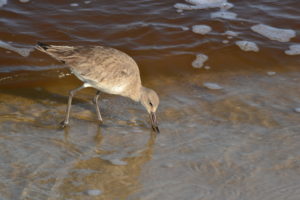 signs and trails of the critters that live just a few inches below the surface. Follow a winding trail to discover a tiny horse shoe crab burrowing into the sand looking for a meal of microalgae. Another trail will lead to the moon snail or a sand dollar. The sea stars are often stranded by the absence of water as well as several species of hermit crabs and snails. And of course, the shore birds are always present, poking their bills into the sand looking for worms and small crustaceans. They are the “original beachcomber”!
signs and trails of the critters that live just a few inches below the surface. Follow a winding trail to discover a tiny horse shoe crab burrowing into the sand looking for a meal of microalgae. Another trail will lead to the moon snail or a sand dollar. The sea stars are often stranded by the absence of water as well as several species of hermit crabs and snails. And of course, the shore birds are always present, poking their bills into the sand looking for worms and small crustaceans. They are the “original beachcomber”!
Away from the water, at the higher reaches of the upper beach, you will find the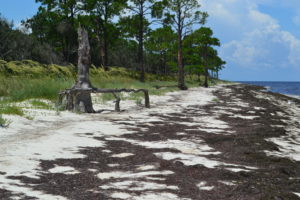 specialists; species of flowers, trees and plants that withstand the extremes of sun, wind, salt, and storms. This is where the ”wrack line” lays, a collection of bits and pieces of everything that came in with the tide. If there are small holes in the sand, look closely to see a ghost crab hiding at the entrance to its burrow waiting for nightfall to venture down to the water’s edge. The night before, a sea turtle may have nested at the highest point from the water, and the “turtle krawl’ tr
specialists; species of flowers, trees and plants that withstand the extremes of sun, wind, salt, and storms. This is where the ”wrack line” lays, a collection of bits and pieces of everything that came in with the tide. If there are small holes in the sand, look closely to see a ghost crab hiding at the entrance to its burrow waiting for nightfall to venture down to the water’s edge. The night before, a sea turtle may have nested at the highest point from the water, and the “turtle krawl’ tr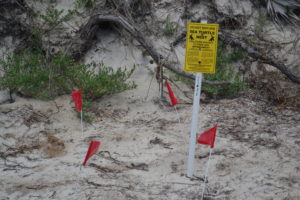 acks may still be visible, as well as the tracks of mammals such as raccoons, deer, wild pigs, and maybe the elusive Florida black bear.
acks may still be visible, as well as the tracks of mammals such as raccoons, deer, wild pigs, and maybe the elusive Florida black bear.
The list of what you may discover is endless, and all it takes is the desire to explore and ‘get a little sand between your toes’.
Explore the nearby beaches of the ‘Wilderness Coast’ with GSML naturalist and certified 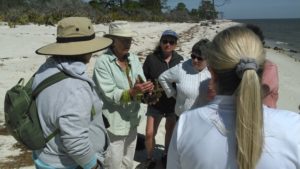 Green Guide Debbi Clifford. In an easy 2-3 hour walk, learn about the natural history of local shore life: shells, critters, plants, and that strange ‘blob on the beach’.
Green Guide Debbi Clifford. In an easy 2-3 hour walk, learn about the natural history of local shore life: shells, critters, plants, and that strange ‘blob on the beach’.
Participants should bring water, dress for the weather, wear water/beach shoes, hat, bring sunscreen/insect repellent as needed.
Adults $20 / children (5-12yrs) $10
Group size limited to 10 people
Please call 850-984-5297 to make reservations and more information
Tour meets at Gulf Specimen Aquarium
Debbi has been exploring the beaches of Wakulla & Franklin counties for the past 25+ years as a marine life collector for Gulf Specimen Marine Lab in Panacea, FL. She is a certified Green Guide and a member of the Florida Green Guide Association.
